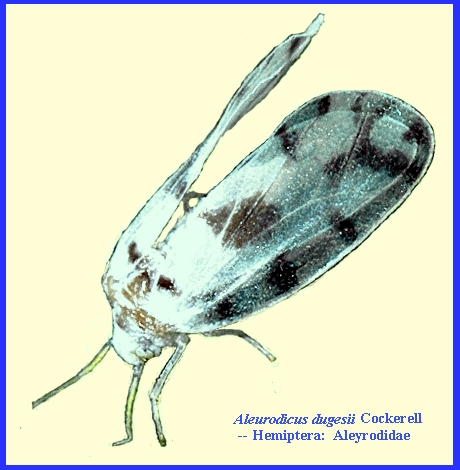File: <giantwhitefly > Pooled References GENERAL
INDEX [Navigate to MAIN MENU ]
|
Giant Whitefly Aleurodicus dugesii Cockerell --
Hemiptera: Aleyrodidae |
|
|
------ CLICK on photo to enlarge. To search for Subject Matter, Depress Ctrl/F
----------------------------------------------------------------------------------------------------------------------------------
|
Many
ornamental plants are damaged by this whitefly including hibiscus, begonia,
bird of paradise, lilies, and banana, and has also attacked citrus
trees. The wide host range and an
ability to reproduce rapidly in the absence of natural enemies make it one
the most serious pest of ornamental plants and home landscapes in California.
Reproduction is rapid and population levels may become quite high
particularly on some hibiscus plants.
Young whitefly nymphs produce large quantities of wax, which coat the
undersurface of leaves. Whitefly
adults and young feed on plant sap, removing
important nutrients. This
causes defoliation; stunting and the plant will die. Sticky honeydew is also excreted by
whiteflies while they feed, covering leaf surfaces and other nearby plants
and favoring the growth of black sooty mold.
The insect also spreads into houses and automobiles and will infest
clothing as well. There has been
considerable public annoyance to this pest, which in some people manifests
severe allergenic symptoms. Until
there are natural enemies found in Mexico and established in the United
States there are two temporary control procedures for the giant
whitefly. One is to periodically
spray affected plants and surfaces with hose water to wash away webbing and
sugary deposits left by the white flies.
If there are ants present around the infestations a second mode of
attack would be to scatter fire ant bait around the premises. The baits may be found in most hardware
stores, and although they were developed to control fire ants in the
southeastern United States, they are also effective against the Argentine ant
which at times are found in large numbers in and outside dwellings. These ants seek the sugary deposits of the
whiteflies and actually protect them from predatory insects. REFERENCES:
FURTHER
RELATED REFERENCES Clausen, C. P. 1978. Aleyrodidae. In: Introduced Parasites and Predators of
Arthropod Pests and Weeds. U. S.
Dept. Agric. Agric. Handbk. No. 480, Washington, D.C. 545 p. Cockerell, T. D.
A. 1896. A Mexican Aleurodicus. Canadian
Entomologist 28: 302. DeBach, P. 1974.
Biological Control by Natural Enemies. Cambridge Univ. Press, London, New York. 323 p. Dreistadt, S. H., J.
K. Clark & M. L. Flint. 2001. Integrated Pest Management for
Floriculture and Nurseries. UCANR Publication 3402. Oakland, CA. Hidayat, P.,
E. Maryana, Y. M. Kusumah & L. Nurulaila. 2019.
Host range and population density of the giant whitefly Aleurodicus dugesii Cockerell
(Hemiptera: Aleyrodidae) on horticultural crops in Cipanas-Cianjur, West
Java, Indonesia. Southeast Asia Plant Conference. Bogor, Indonesia 2019 14 August 2019. Conf. Ser.: Earth Environ. Sci. 468:
012008. Kennett, C. E., J. A.
McMurtry & J. W. Beardsley.
1999. Biological control in
subtropical and tropical crops.
Bellows, T. S. & T. W. Fisher (eds.), Handbook of Biological
Control:
Principles and Applications. Academic Press, San Diego, New York. 1046 p. Kodama, G. 1931.
Studies on Aleurocanthus
spiniferus Quaint. Kagoshima-Ken, Kyushu, Japan. 38 p. (Abstract in Rev.
Appl. Ent. (A): 113). Kuwana, I. & T.
Ishii. 1927. On Prospaltella
smithi Silv., and Cryptognatha sp., the enemies of Aleurocanthus spiniferus, imported from Canton,
China. Journal Okitsu Horticulture
Society 22: 77-80. Kuwana, I. 1934.
Notes on a newly imported parasite of the spiny white fly attacking
citrus in Japan. 5th Pacific Science
Congress Proc. (1933) 5: 3521-3523. Nakao, H. K. &
G. Y. Funasaki. 1975. Introductions for biological control. Proceedings Hawaiian Entomology Soc.
22: 329-31. Peterson, G. D.,
Jr. 1955. Biological control of the spiny whitefly in Guam. Journal of Economic Entomology 48: 681-83. Sawada, E., N.
Ikeda & K. Tanaka. 1932. Studies on Prospaltella smithi
Silv., an enemy of Aleurocanthus
spiniferus Quaint. Japan Dept. Agric. & Forestry Bureau
of Agricultural Materials for Agriculture Improvement 42: 1-28. Sampson, W. W. &
Drews, E. A. 1941. Fauna Mexicana IV. A review of the
Aleyrodidae of Mexico. Anales de la
Escuela Nacional de Ciencias Biologicas
2: 143-189. Schoeller, Erich N.
& Richard A Redak. 2018. Temperature-Dependent Development and
Survival of Giant Whitefly Aleurodicus dugesii (Hemiptera: Aleyrodidae) Under
Constant Temperatures. Environmental
Entomology, Volume 47, Issue 6, December 2018, Pages 1586–1595. Smith, H. D., H. L.
Maltby & J. E. Jimenez.
1964. Biological control of
the citrus blackfly in Mexico. U. S.
Dept. Agric. Tech. Bull. 1311: 30 p. Windbiel-Rojas, K.
& Sikes B. Messenger. 2020. Pest Notes: Sooty
Mold. UC ANR Publication 74108. Oakland, CA. Chiappini, E., S. V. Triapitzin & A. Donev. 1996.
Key to the Holarctic species of Anagrus
Haliday (Hymenoptera: Mymaridae) with a review of the Nearctic and
Palaearctic (other than European) species and descriptions of new taxa. Journal of Natural History 30: 551-595. Triapitzin,
S. V. 1995a. The identities of Anagrus (Hymenoptera: Mymaridae) egg
parasitoid of the grape and blackberry leafhoppers (Homoptera: Cicadellidae)
in California. Pan-Pacific Entomol.
71 (4): 250-251. Triapitzin, S. V. 1995b. A review of the Australian species of Anagrus (Hymenoptera: Mymaridae). Russian Entomological Journal 4
(1-4): 105-108. Triapitzin,
S. V. 1997. The genus Anagrus
(Hymenoptera: Mymaridae) in America south of the United States: a
review. Ceiba (Zamorano,
Honduras) 38 (1): 1-12. Triapitzin,
S. V. 1998. Anagrus
(Hymenoptera: Mymaridae) egg parasitoids of Erythroneura
spp. and other leafhoppers (Homoptera: Cicadellidae) in North American
vineyards and orchards: a taxonomic review.
Transactions of the American Entomological Society. 124 (2): 77-112. Triapitzin, S. V. & D. Strong.
1995. A new Anagrus (Hymenoptera: Mymaridae), an egg
parasitoid of Prokelisia spp. (Homoptera:
Delphacidae). Pan-Pacific Entomol. 71 (4): 199-203. Triapitzin, S. V., R. F. Mizell III,
J. L. Bossart & C. E. Carlton.
1998. Egg
parasitoids of Homalodisca coagulata
(Homoptera: Cicadellidae). Florida Entomologist 81
(2): 241-243. Walker, G. P., N. Zareh, I. M. Bayoun & S. V. Triapitzin. 1997.
Introduction of western Asian egg parasitoids into California for
biological control of beet leafhopper, Circulifer
tenellus. Pan-Pacific Entomologist 73 (4): 236-242. |
